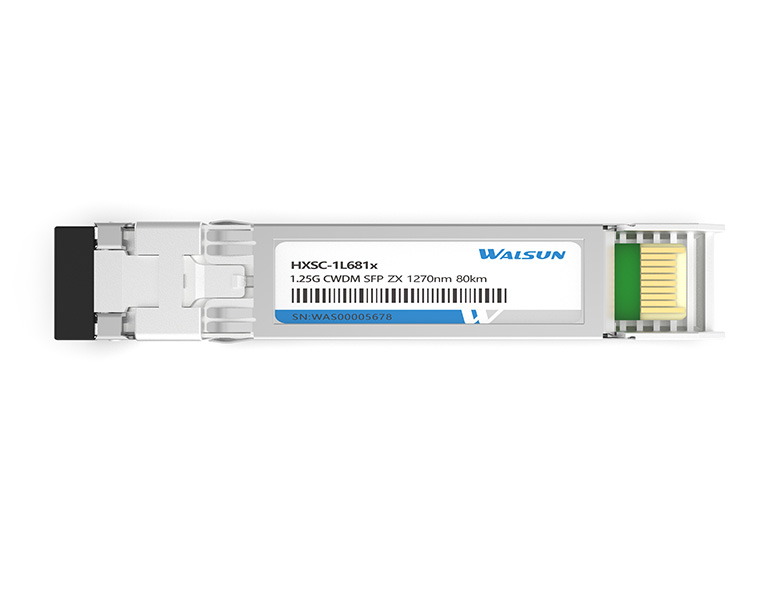

 Knowledge Base +
Knowledge Base +  2024.03.04
2024.03.04As providers densify their networks by pushing fiber deeper and adding small cells to meet the increased growth in demand for speed and capacity, coarse wave division multiplexing (CWDM) and dense wave division multiplexing (DWDM) offer two effective ways to increase the bandwidth of fiber by combining optical signals of different wavelengths on one fiber strand. It’s a practical, proven solution; however, which WDM option is the best choice for your network?
Whether coarse or dense, WDM technology is ideal for making the most out of new and existing fiber deployments. Providers implement WDM by adding coarse or dense modules to their headend or hub locations, after considering the key differences between the two.
Overview of CWDM SFP
CWDM SFP is a kind of optical transceiver that utilizes CWDM technology. Similar with traditional SFP module, the CWDM SFP is a hot-swappable input/output device. It plugs into an SFP port or slot of a switch or router and links the port with the fiber-optic network. CWDM SFP transceiver modules make use of the SFP interface for connecting the equipment and use dual LC/PC fiber connector interface for connecting the optical network. Colorful CWDM SFP modules are displayed below.

It is well known that CWDM SFP modules come in 8 wavelengths covering from 1470 nm to 1610 nm. Color markings on the devices identify the wavelength to which the Gigabit Ethernet channel is mapped. The following picture lists the CWDM SFPs with their wavelengths and color codes.

DWDM SFP Overview
DWDM (Dense Wavelength-Division Multiplexing) SFP transceivers are used as part of a DWDM optical network to provide high-capacity bandwidth across an optical fiber network, which is a high performance, cost-effective module for serial optical data communication applications up to 4.25Gb/s. There are 32 fixed-wavelength DWDM SFPs that support the International Telecommunications Union (ITU) 100-GHz wavelength grid. An inner structure of DWDM SFP is shown below.
Application
CWDM SFP transceiver is widely used in optical communications for both telecommunication and data communication. It is designed for operations in Metro Access Rings and Point-to-Point networks using Synchronous Optical Network (SONET), SDH (Synchronous Digital Hierarchy), Gigabit Ethernet and Fibre Channel networking equipment. The DWDM SFP can be also used in DWDM SONET/SDH (with or without FEC), but for longer transmission distance like 200km links and Ethernet/Fibre Channel protocol traffic for 80km links.
CWDM vs DWDM, Which Do You Prefer?
The tremendous demand for more bandwidth has triggered the DWDM's development, which makes it more favored in the market. And it has experienced great advancement in cost reduction. However, CWDM still has the price advantage for connection rates below 10G and for short distances. With low data rates, it is currently more feasible. In this way, CWDM and DWDM each will provide a unique “fit” in the OTN network, and will complement rather than replace each other in the future.
Conclusion
We hope this article clarified the benefits, functionality, and advantages of CWDM and DWDMs. The main takeaway is that using the capabilities of CWDM and DWDMs, fiber optic cable is nearly limitless – that goes for existing cable as well as new deployments. Understanding this can save you time, effort, and most of all, a lot of money!
Walsun carries a wide variety of CWDM and DWDM components, as well as the DZS O-Series of environmentally hardened optical transport products that are optimized for high capacity and long-reach mobile backhaul scenarios.
Optical networking plays a key role in today’s multi-layer networks and is used to extend the reach of traditional pluggable optics, interconnect data centers and tie sites together within a campus or business park across metropolitan regions, between cities, or for long-haul national connectivity. As a result, public sector organizations, utilities, healthcare providers, financial institutions, corporate enterprises, and data center operators are considering optical transport to be the solution of choice for their mission-critical networks.
With the massive growth of over-the-top applications, cloud computing, mobile devices, and the need for consumers and employees to have constant access to their data and applications, CWDM and DWDM optical networking solutions are rapidly being adopted by businesses as their bandwidth and distance requirements continue to grow. Thus, many organizations across industries are now operating their own optical transport networks to consolidate high rates of bandwidth and different traffic types across long distances.
Subscribe to the newsletter
for all the latest updates.
2-5# Building, Tongfuyu Industrial Zone, Aiqun Road, Shiyan Street, Baoan District, Shenzhen. China
